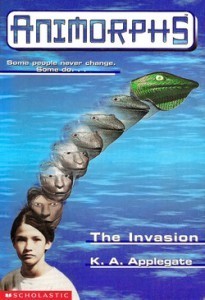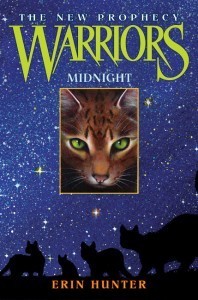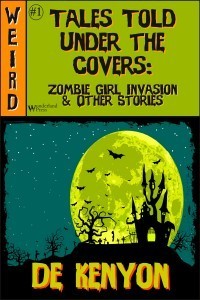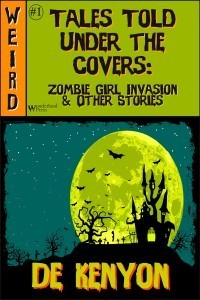DeAnna Knippling's Blog, page 90
October 18, 2011
Indie Review: Young Guns by Ian Healy (5)
A cop, a dad, or a superhero?
The main character's daughter, who, if I remember correctly, is sixteen or seventeen, has the same superpowers as her father, but chooses to use them with the young guns. A nice story about reconciling the irreconcilable.
Superteens…gotta love 'em.
October 17, 2011
Indypub: Cover design?
Over the last few weeks, I have designed several covers, including two for POD books (which I put more time into than the weekly stories, honestly), and worked with an honest-to-goodness graphic designer in training (not my brother) on an ebook cover, which meant I had to explain ebook stuff.
Some thoughts:
Simple ebook cover design: Pick a picture that looks good in mini (Smashwords home page) format. Put a very large title on it in a color that contrasts well. Author name can be smaller; tag line can be smaller still. Images from stock photo, fonts from Dafont, handle image with GIMP.
Things that go together should have the same cover design, more or less.
Personality counts. It's better to capture the personality of a story than the literal truth.
More complex cover design: Find out where your book fits in the market, what covers of books like your book look like. Consider borrowing an element or two from their covers, but don't be too copycat. Consider borrowing elements from other books that aren't in your market exactly–but are in a related market. Like copying some elements of an adult thiller cover in a YA thiller cover. Copying some romance cover elements in a fantasy-romance cover. Copying comic-book cover elements (ahem) in a middle-grade cover.
Sometimes the cover design for big-publisher books is no good. So don't copy the covers that don't light you up.
That was the lesson from this morning. I struggled and struggled and struggled with the cover for Exotics #1: The Floating Menagerie…AUGH! I've been mentally building and rebuilding this cover since I put one together for Rachael, as a gift book, TWO YEARS AGO.
The two closest book-neighbors to this one are Animorphs and The Warriors series.
I have very carefully not read any of these books; the series is just too close to the premise of Exotics, and I don't want to pick anything up. The main things this cover communicates to me are: part of a series (series title in big font), about a kid who changes into an animal. This looks modern day and science-fictiony…but it's a very simple cover. Background, foreground image, plain text layouts, done. I go, "Which book is this in the series?" and "I don't know, but it's the one with the kid that changes into the lizard." As an adult, I don't really find it appealing. I'm not sure about kids–I mean, they read it, but there's probably a reason people put Harry Potter cover posters on their walls and not Animorphs.
Interestingly, if you look up later editions of the Animorphs covers, they start to look more like Warriors covers.
The Warriors series covers generally look more attractive and more well-designed: a picture of a cat in some kind of cutout window in the middle, and a scene in the background. Again, the series title is prominent, and because there are sub-series, the subseries name is on the cover, too. These are generally just pretty covers, but they can be kind of confusing at times, when the background picture is a fully-developed image instead of a silhouette image, as here.
What are these books about? Cats. Probably not science-fictiony cats, but other than that, we're not sure. For example, with most of the Redwall covers, you go, "Okay, high fantasy with mice. Got it."
And which book is this in the series/sub-series? In addition, what's the order of the sub-series?!? ACK! This bothers me and has actually prevented me from buying any of these books for my daughter, because I have no idea whether she's read it before or not. Manga = number on the cover. I like that. I hate it when there's no shorthand for which book goes where, especially in multi-generational series where it's almost impossible not to have a story spoiled when you read the books out of order.
Okay. So here's my test cover (third version this week). It has its shortcomings; I'm no graphic designer.
This is a book about kids who can turn into animals, in exotic locations. As a rough shorthand, I describe it as "Alias for kids." Lots of betrayal, switching sides, and wheels within wheels.
What worked from the other covers: both showed animals. Both had their series titles in distinctive fonts.
What I didn't like about the other covers: give me series order or give me death.
What worked from Animorphs: You can tell which book it is by the cover. This is the book where they're on the ship; the wolf is the first Exotic the main character meets.
What worked from Warriors: The extra design elements give their covers more visual appeal and make it seem like the words inside will be well-written, maybe even a little philosophical. (Silhouettes against a starry background: pretty philosophical.)
Having the series title work is especially important, because I'm taking a big risk on the book titles by putting tough vocabulary words in each of them. The series title is how I refer to the books, so other people probably will, too.
What I feel like I'm missing:
A sense of action. I think that comes from using the wolf lying on the ground. And, really, Raoul never really holds still…except when he's had the crap beat out of him by the bad guys. So I think that particular wolf has to go.
What I disregarded:
Thriller covers. Guh…I hate most thriller covers. I keep going, "What is this book even about? Is it even in a series? Why is the title so completely freaking bland and nonindicative of what I'm reading? Do they want me to be confused?!?" They might sell books, but I'm just not cut out for it. I feel like the cover design is telling me, "Thrillers are interchangeable…except that you want to be loyal to the writer." Because the writer's name is usually as big if not bigger than the title. "What's important here is that you're reading a LEE CHILD book. LEE CHILD. Got that? LEE CHILD." Nothing against Lee Child; he's just showing up in searches.
Colors:
I'm not sure about the colors. Logically, I feel like I need to use some bright blue on the cover (it shows up along with Raoul in later books), but I may have to be satisfied with the "alice blue" of the fonts. This isn't a neon-colors kind of story, or even winter-colors (dark and rich but clear) kind of story. Dramatic, serious at times, complex. Probably darker colors, strong but shaded, are better. I looked up Alias, and yes. Those colors. The season box set covers would make great ebooks, come to think of it. I may darken the background darks just a hair.
Series:
I worked hard to find something that I could reproduce over five covers, by the way. Animal in front, setting in back.
October 14, 2011
Fiction: The Vengeance Quilt
Now available at Smashwords, OmniLit, B&N, and Amazon.com.
The Vengeance Quilt
by DeAnna Knippling
God's work weighs on Sebastian, a new priest, harder than most. But dealing with demons is his penance, and God never makes a burden harder than you can carry. Or so he believes when the rivalry between two of his parishioners spirals into the supernatural. A Weird West tale.
A Jennings Brothers story set in the same world as Chance Damnation. Can be read in any order.
In his own head, he wasn't Father Vincent Paul; he was Sebastian Jennings, a murderer. He hadn't meant to become a violent man. He grimaced at himself in the mirror: now there was a face that would inspire his parishioners to love God. He checked his teeth, smoothed down his hair, and smiled. Even worse.
It was an August Saturday evening in the year of our Lord 1960, so he said Mass in his green vestments. He used to take more pride in his robes than any woman over designer dresses; now it was one more sign of his falseness under the glory of God.
He stepped out of the changing room. His older sister, Peggy, was waiting outside the door. "Sebastian? There's a problem downstairs." She wore an apron and twisted a wet towel in her hands. One side of her stylish dress was black from coffee or dishwater.
"What is it?"
"Claire and Eileen are fighting over the quilt for the harvest festival."
"You should have interrupted me." He rushed down the basement stairs.
Claire, a small woman with mousey hair, shouted, "That quilt doesn't belong to you!"
Eileen, a much larger woman dressed in a tent, shouted back, "I paid for it!"
Claire Christiansen was married to Frank Christiansen, one of Don Hart's hired hands. Eileen Hart was his wife. The two women stood in the kitchen with the service window shut, as if that would make them less audible to the people drinking coffee or the kids gaping from their catechism class doors. Sebastian held up one hand to keep Peggy from trying to smooth things over; he wanted to hear what the fight was about.
"You said the money was a donation!" Claire shrieked.
Frank Christiansen came toward the kitchen door, but Sebastian held him back, on hand on his chest.
"I hired you to make me a quilt!"
"You are the most selfish—I'm not going to say! I'll give you back the money after we auction it off."
"It's my quilt!"
"Then just take it, you cow!"
"I'll have your husband fired!"
"I just told you that you could have that damned quilt!"
Eileen noticed the others outside the kitchen door. Her blue eyes creased up at the corners. "You heard that, Father!"
"That's enough, ladies," he said. "You're scaring the children."
Claire turned around. She had a coffee cup and a towel in her hands; she put them down and walked toward him, her heels clicking precisely on the linoleum.
She glared at him with eyes so dark as to seem black. "There's a commandment about those who bear false witness." She went in the ladies' room, slammed the door, locked it, then turned on the faucet, high-blast.
Eileen leaned back on a counter with a grin on her face.
Sebastian said, "I understood the quilt was a donation as well."
Eileen said, "It's my quilt. I paid for it."
"Just for the materials?" Sebastian said. "Or for the time she spent on it as well?"
Eileen frowned. "That ain't worth nothing. She owes me for lots of things. Milk."
"I'd like to see an agreement for payment for her work, typed up and signed by both of you. And it would be very disappointing if I heard that Frank was fired over a disagreement between a couple of ladies."
Eileen turned up her nose and lumbered out of the kitchen. She climbed the stairs slowly, dragging on the rail. "He could get fired for lots of reasons," she shot over her shoulder, just as she turned the corner and went out of sight.
October 13, 2011
Out to the River
The first couple of years that I was in college, I would do something incredibly stupid from time to time. Well, I suppose whether you think it's stupid or not depends on when you were raised…no, the reason why you might think it was stupid would depend on when you were raised, I think.
I would take off on cold Friday nights and walk out to the river.
The walk was, I don't know, maybe three miles or so. Not terribly far. I'd walk out of the dorms, through most of town, down the hill, and on the county road that led south to the Missouri. For some reason, I think every time I went that it was warm, I went with other people. In the cold, sometimes people came with me, but mostly I went by myself. At least, that's how I remember it.
I walked and walked and walked, past town and down the hill and over the bridge to the creek and on and on, until finally I turned right and walked down a farmer's dirt road, then across a couple of fields, duck through a barbed wire fence, and into the woods. There were paths through the woods. I went out once when the snow was falling in a quiet hiss and the brush caught most of it before it hit the ground. The lights from town were orange and lit up against the backside of the clouds, which more or less what lit my way.
I heard at one point that drunken frat boys had taken a gay guy out into the woods and murdered him, stringing him up from a tree branch with barbed wire. Or else it was an Indian guy. I never found out for sure if either story was true. This was a time when girls were scared to walk from one side of campus to the other; you could call campus security, and they'd walk you from one dorm to another. But what about the campus security guys? I always wondered. One, what if one of them decided to rape you? And two, what if one of them got attacked in the night? My thought was, stay away from frat parties and stay out of other people's rooms when they're drunk, male or female. It did me well. I heard another story about a girl who was murdered and stuffed up in the air ducts in one of the dorms that I actually had to give more credit to. She'd been staying over the summer, and…anyway.
I'd walk through the paths and out to the bank of the Missouri.
The river would be black with specks of light. Silver light from the moon or the stars, orange light from the dull, reflected glow of the street lamps. And sometimes just…light. I'd avoid any partiers and work my way down to the beach from the banks.
The waterway would change. Sometimes I'd go, and a tree on the bank, maybe twenty feet up, would be fallen in, and I'd climb down on it. Or it'd be gone and I'd have to work around another quarter-mile or so, trying to find a place. The bank would be all dirt; the beach was sand or silt.
I'd get my feet wet, through my shoes, and watch the water moving downstream, and listen to the cows honking at each other. I called them the Satan cows, because the echo off the water would twist the sound around.
Something would happen, and I'd suddenly feel cold and frustrated that I had to walk all the damned way back.
And then I'd go home. Only, you never called the dorms "home." It was "the dorms" or "back to your room." My legs were so cold that my jeans would rug-burn my legs as I walked; the insides of my knees and my upper thighs were always raw. I'd go home and be starvingly hungry, with no money and no way to get anything to eat until the meal halls opened up in the morning. Or I'd eat cereal smuggled out in the college mug. One or the other. My lips would bleed from being cracked open and I wouldn't have any lip balm.
One of the nights was right before Christmas. On the way back, I was hit with the realization that I hungered for those lights. On the way out I hadn't cared. But I've never felt apathetic about Christmas lights again.
What was I looking for out there? It wasn't until I walked out there with Lee that I realized how…pointless it was. Alone, in the dark. Woo. And yet something dragged me out there for about two years straight, maybe twice a month. Always Friday nights. I would talk myself out of being around people, just so I would be lonely enough to go.
The water, the walking, the coming home and pulling back the layers of scarves and hats and hoods from my head. I had gone, and then I had come back. I went and faced something (or fed it, or both), and always felt quite accomplished when I came back.
It was never as much of a walk, in the daylight.
I'm not sure why I had to write about this tonight, but I did. The lights are out, the cat is snoring, and I'm typing by the glow of the monitor. And that's right, too.
October 12, 2011
Print version now available: Tales Told Under the Covers
If you are interested in a print copy of Tales Told Under the Covers: Zombie Girl Invasion & Other Stories, it's available throughCreateSpace for $9.99, plus shipping. Within a week, it should be available via Amazon, and after a few weeks, through other online venues. Eventually, I'll set up my own store…but not today 
October 11, 2011
NaNoWriMo is a-coming!
NaNoWriMo is coming up.
For those of you who don't know, National Novel Writing Month is a project that some guy, Chris Baty, and his friends just started doing one year. Like all writers at one time or another, they decided to bite off more than they could chew.
"Hey! Let's write a novel in one month! Fifty thousand words! YAHHHH!"
Could it be done? Should it be done? Much like aficionados in any extreme sport, they ignored their internal editors and forged forth, writing and delighting themselves and despairing of ever being writers. Ever. And either finishing or not finishing their novels.
Some people dropped out.
Some people decided to do it again the next year. And the next. The word spread, and the NaNoWriMo format of extreme writing became more popular. There are more extreme ways to do it–writing a novel in a week, for example–but NaNoWriMo happens to be a fairly reasonable way to do it.
This year, I'm going to help at the Pikes Peak Writers NaNoTryMo, in which you can set yourself any goal, hang out at the Citadel Mall Imagination Center on Tuesdays from 6:30-8:30 p.m., and write with other like-minded (insert hand gesture of spiral next to skull here) writers for a couple of hours. We'll also have a full day write-in on November 19th, but I'm not sure what the exact hours are yet. By "help" I mean set up chairs and egg people on.
Because PPW membership is free, if you feel like joining us, just show up. There's a Starbuck's down the hall and shopping therapy if your characters break your heart.
Me, I'm going to be working on Alice's Adventures in Underland (finally!). Life is good. How about you?
October 10, 2011
Tales Told Under the Covers: Zombie Girl Invasion & Other Stories
Looking for something Halloweenish, with zombies, pirates, robots, ghosts, death, and other adventures for a middle-grader?
Tales Told Under the Covers:
Zombie Girl Invasion & Other Stories
by De Kenyon
Now at Smashwords, OmniLit, Amazon.com, and Barnes and Noble.
Ten tales of death, invasions from other realms, bullies, babysitters, liars, and the brave kids who fight back. Zombie girls who have to hide, lest they get eaten by bigger zombies. Food that bites back. Wizards who are scared of their own power. Murdered (and murderous) pets. Secret superpowers. And that last, great voyage into the unknown.
Stories to be whispered under the covers, by flashlight.
Stories to be read by firelight to the robots who come out of the woods.
Stories to be told when the witches are ready to eat you but want to hear just one more story before they shove you in the oven.
Creepy Stories. Fantastical Stories. Weird Stories.
From Attack of the 50-Foot Sushi Monster: Sometimes playing with your food can be deadly.
A hand reached from behind Cat, delivering a sushi roll on its tiny wooden table.
"Ewww!" her friend Marilyn squealed. Other kids laughed or made faces.
Cat rolled her eyes. "Just try it. It's really good."
Marilyn shook her head; she'd never eaten sushi before. But Cat was no scaredy-cat. She'd eaten sushi plenty of times.
But this wasn't what she'd ordered. She's ordered crab and masago, orange eggs so tiny that they crunched when she ate them—her favorite. Instead, the waiter had brought her a roll in the shape of a doll, with two seaweed-covered legs, strips of sesame seeds and masago on its belly, and avocado arms. The doll scowled at her, tiny pieces of seaweed snipped into a face on top of a piece of tuna.
Maybe that's what the sushi restaurant made for everybody on their birthdays. She didn't know.
The sushi-doll's hands, made out of tiny green leaves, seemed to move, but it must have been the wind or something.
The waiter reached over and stuck a candle in a pile of green wasabi and lit it, and the kids and parents around her started to sing Happy Birthday—
Suddenly, the sushi-doll sat up, and everyone screamed, including Cat. The sushi's head turned back and forth, still scowling at everyone, and its little mouth opened into an O.
"You murderers!" it squeaked. It pushed itself off the wood, bending one knee underneath it, then slowly, wobbly, getting to its feet. "Sushi killers!"
October 9, 2011
Indypub: Basics of Ebook Design and Formatting
This came up with one of my clients recently. I hadn't realized that this was stuff my clients wouldn't know, but some of them are just starting out in ebooks, so I thought I'd put it in a more coherent format, to help me think it through.
—
Ebooks are different than print books; they're even different than the PDFs that you may have been putting up on your website as loss leaders for your other products.
The same things that can make a book or PDF successful and attractive to look at can make an ebook extremely difficult and annoying to read as an ebook. While ebooks can be read on a computer, they are designed to be read on the much smaller screens of Kindles, iPhones, and other ereaders and smart phones.
For example, if you have a lot of indenting in a book, with multiple sets of indents, this can cause problems on a teeny tiny iPhone, leaving a column of words 5 or 6 letters long at some points.
If you have a lot of different font sizes in a PDF, with some at 22 and some at 12, this can be extremely difficult to read on a phone, where you can set the font size as big as you want it: that 22 size font might fit only 3 letters on a screen, at some settings.
If you have a lot of colored text in a PDF, the effect can be lost on a black-and-white ereader.
If you have an unusual font, the ereader or smart replace the font with something else entirely…it's all up to the reader.
The main things to keep in mind are:
People will read your ebook on all kinds of devices, from PCs with 20-inch monitors to 3-inch smartphone screens, in color or black and white, using all kinds of diffferent software.
The simpler your ebook design is, the better.
Follow the guidelines at Smashwords or wherever you're submitting ebooks, or your readers will have problems. If you're having the conversion done and selling the ebooks directly on your site, use the same guidelines to start with–your readers will have most of the same issues regardless.
Test you ebook on several devices, in several formats.
Cover images must look good at full screen size, ereader size, smart phone size, and the teensy tiny list view on Amazon.com size.
Overall, the best thing you can do to get a feel for good ebook design is to get an ebook reader or a smart phone and use it to find, download, and read ebooks. You don't have to cover all the formats, but you will get a far better idea of what your readers experience–what's annoying, what's helpful, and what's worth your time to do.
October 7, 2011
Indypub: Roadmap
I get to talk at the Pikes Peak Romance Writers about indie publishing on October 23, and I'm trying to brainstorm a handout.
Here's a draft…
Want to put up an ebook but don't know how? (Or just want more facts before you make up your mind?) Here are the bare minimum steps you need to consider when self-publishing an ebook:
Material. Short stories that are not under an exclusive contact with their publisher are probably ideal (they've already been edited). However, any story to which you own the rights will work. If you don't know if you have rights to your story, please read The Copyright Handbook by Stephen Fishman at Nolo Press. (Nolo Press = lots of good business of freelancing books.)
Freelance Writing Business. Even if you are not going to be a full-time freelancer, you need to set up your business to help prevent IRS issues and other problems. See Nolo's checklist, "Start Your Own Business: 50 Things You'll Need to Do." You will not need to do most of the things on the list. You may want to consider setting up a small press; see Dean Wesley Smith's Think Like a Publisher series to help clarify the issue. You can decide to be a small publisher later; however, simplify your life by setting your writing business up first.
Marketing. 1) Author website. 2) Social media like Twitter or Facebook (I love Goodreads, too). 3) Keep an eye out for reviewers; expect to send them FREE copies. Someone recommended the list at Step-by-Step Self-Publishing, and I'm going to use it on the next book. 4) Specialty markets relevant to your specific book – e.g., fishing websites if you're selling a fishing murder mystery. 5) Local writer groups = word of mouth.
Editing. If you know how to edit and are confident in doing so, you can edit your own stuff. If not, get editing, by hook or by crook. Think of it like hiring a babysitter and ask around; if you're on social media, you can put out the call that way, too. (I'm a former tech editor, so I do my own on most things–although I have something coming up that I plan to hire an editor for, because it's outside my usual genres.)
Formatting. Read the Smashwords Style Guide . Follow it. As you become more advanced (or if you already have the skills), you may want to do the formatting directly in HTML; that's beyond the scope of this blog.
Cover. Create a cover using images for which you have the rights, either 1) your own private images or 2) images that you have obtained from a stock photo company or have a signed contract from the artist. Do not do an Internet search for images that can be modified; just because it has that label doesn't mean that you have the right to do so without contacting the artist. I use Dreamstime, then modify the images to add design elements, title, author, and tagline information using GIMP or Scribus. Look at the cover sizes at Smashwords: your cover must look readable & interesting at teensy size.
E-Publishing. I recommend publishing at Smashwords, which feeds to all kinds of other sites, like Sony and Apple. I also publish directly at Kindle Direct Publishing (Amazon) and PubIt! (Barnes & Noble). IF you follow the Smashwords style guide but remove all references to Smashwords from your ebooks, you can use essentially the same files to publish to PubIt! and KDP. There are more advanced ways to do this, but this will get the job done. You can publish at B&N and Amazon via Smashwords, but SW always takes forever to report sales that aren't from Smashwords, and B&N/Amazon are not too terribly high on the learning curve. If you do publish at all three sites, make sure you turn off the Distribution Channel Manager for those two channels, of B&N/Amazon might get annoyed at having two copies of everything.
Validating. After you have published, check your files and decide whether you can live with any weirdness.
Announcement. Announce publication via any marketing you have set up.
Patience.I hate being patient. Hate it, hate it, hate it. Least favorite part of the whole thing.
TIPS:
DRM or not? I do not. In a digital age, I am more afraid of being ignored than copied.
Pseudonyms or not? I do, mostly because I don't want kids to unintentionally read my adult work. This causes problems: 1) I had to set up as a small publisher, to keep things at least somewhat organized, which has its own headaches; 2) You have to do all your marketing efforts all over again for each pseudonym AND for the small publisher; 3) Building a reputation is that much slower, because you're splitting up your writing time between authors.
Will I sell a million copies? No. From what I hear, things start to take off when you have about 25-35 things (short stories, etc.) posted. PER AUTHOR. If you go by DWS's estimates (from the Think Like a Publisher series, above), ~5 copies/short story or collection/month, ~25 copies/novel/month. AFTER you have those 25-35 things up. I'm not seeing it yet.
What if I mess something up? You will. Take the story down, fix it, and repost.
Can I sell a story if it's online elsewhere for free? Yes, if you have the rights. Ebook cover/format = value added.
POD or not? Get comfy with epublishing first. POD is fun but probably won't make you any money, unless you're really good at marketing. Personally, I LOVE IT! I'm currently using CreateSpace. I suggest doing a few gift books first to get a feel for it, and read up on how to lay out professional-looking interiors.
Will big publishers hate me for being an indie writer? This should not be a problem UNTIL you are offered a contract. If so, read the fine print very, very carefully to ensure that you can live with their requirements: they may stipulate that you have to stop epublishing anything under the same name or that will compete with whatever you're publishing with them. I would check out The Passive Voice blog, written by a lawyer whose wife is indie publishing. He has some really good caveats and is available to review writer contracts. Laura Resnick also has good information about this.
Should I epublish or submit to markets (novel publishers, agent, short story, or otherwise)? I try to keep one foot in each world and have submissions going to short story and novel publishers all the time. As I feel satisfied that I've been rejected from the markets I want most to get into, I epublish. I also epublish stuff that's been published and I have the rights back on.
AM I A GOOD ENOUGH WRITER TO DO THIS? Only you can answer that question. I have an ebook up about writing, failing, and getting better at it: How to Fail & Keep on Writing. My personal rule of thumb was that if I was getting published with short stories (for money), then I was writing well enough to epublish, too. However, I have a goal to write a story a week, so I have a lot of stories out there; YMMV. If readers are buying your stories: you are writing well enough to epublish; sometimes the only way to find this out is to throw the story out there and let the readers decide.
More questions? Follow other authors who are indie publishing; we talk about our trials and tribulations all the time. Like me! I have posts about publishing, editing, etc. up here all the time–lots of good stuff in my archives.
Anything I'm missing for first-time epublishers? This is a front-back, one-page handout. Is this too much?
Fiction: The Edge of the World
Now on sale at Amazon.com, B&N, Smashwords, and OmniLit.
The Edge of the World
By DeAnna Knippling
His best friend Felix kidnapped him on dragonback to make him go to his abuser's funeral, then tried to blackmail him into abducting changlings for them—the same thing that had happened to him. Fairies suck.
Warning: Strong language.
There's not much difference between the real world and the land of fairies. Just take the number of assholes times ten. Bang! You're in fairyland.
When I said "no," Felix bound and gagged me, tied me onto the back of a prairie dragon, and flew me back to the Edge of the World anyway.
I watched the Edge coming up to meet me, the cottonwoods rustled louder than the dragon's feathers in the heavy wind. The dragon landed right on the Edge, about a thousand feet above the prairie below.
About a thousand fairies had come to see Roberto burnt to ashes. Some were dressed in feathers and quills, as if it were a powwow; others wore Air Force uniforms or business suits with bare feet. The only ways to tell that they weren't human were their ice-blue eyes, and they didn't scream in terror at the dragon. Only mortals scream in terror. It's a selfless act, a way of warning people to stay away or get their guns or whatever. Fairies are too self-involved for that.
I was still wearing my football jersey from practice. Felix cut the rope, and I rolled down the dragon's side and the ground knocked the wind out of me. Felix jumped down and cut my ropes; I had to tear the gag off myself. I couldn't believe they'd sent Felix. Then again, he'd been able to trick me long enough to cast the knockout spell on me when nobody else could have.
They'd laid Roberto's body on a platform made of rough, green pine branches they'd dragged in from Hermit Mountain, rising above the last hills of the Edge. Rick Chamberlain held a bough burning with blue fire, which he tossed onto the base of the platform. Yeah, they'd just been waiting for my feet to touch the ground before they torched him, to make it official.
As soon as I could stand up, I ran over to the man who had abducted me, eighteen human years ago, and spit on his face. I screamed obscenities at him, and, "Why did you do it? Why couldn't you leave me alone?" The man who had abducted me as a baby and held me prisoner in a razor-grass cage when I disobeyed him was dead, and the rest of them wanted me to take over his job.
Stealing kids.
The fire spread quick and hot, until the whole bier was black with smoke and sent sparks over the Edge. My last sight of Roberto was my spit running down his face, like a tear. And turning to steam.
Fucker.










